Montag, 19. Dezember 2016
Sacred Valley
zwinkerschaedel, 02:04h
Sacred Valley
This post describes actually two trips to the sacred valley that I did, one by public transport to Tipon together with two students from the language school and the other a tourist tour to the three ruins of Pisaq, Ollantaytambo and Chinchero. The Ruins of Moray and salt terraces of Maras (see earlier post) also are in the sacred valley.
Tipon:
This is a "water" temple containing many aquaeducts to honor Wiraqucha, the main god that created everything in the Incan mythology. He is representet by the main water body that is then split into two, the next two gods of the sun "Inti" and the moon "Killa" representing male and female. It then breaks down further and for example the 4 water fountains represent the 4 different elements fire, water, air and earth. If something is used with 3 then it usually represents the sky (represented by the Condor), the middle earth (maybe the mountains, represented by the Puma) and the lower earth (represented by the snake). It was also incredible to see the intricate aquaeduct system the Incas used to control the flow and velocity of the water. A very beautifull temple! We went rather late arriving only 1:15h before it closed and we had the place to ourselves with the gorgeous late afternoon light! Well worth the trip.

This is the main water display of the Incan cosmology.
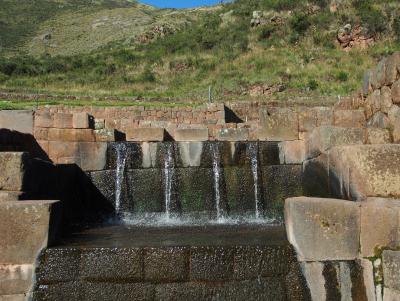
The representation of the 4 elements fire, water, earth and air.
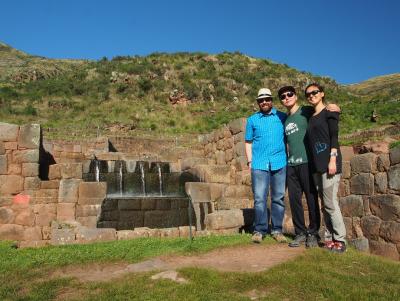
The Korean couple (they chose the "easier" names of Antonio and Tatiana for their travels in South Amercia) that I met at the language school. Two psychiatrists that I've really enjoyed spending time with!
Pisaq, Ollantaytambo and Chinchero:
This is the classic one day trip to the sacred Valley. It is somewhat of a "Kaffeefahrt" (for all non-Germans: this is a trip visiting some interesting place that is used to stop at "artistic" markets on the way to sell the tourists stuff on the way) and I think the tour company receives a provision for the market stops. Sadly that meant hardly enough time at the actual ruins with having to hurry through them and wasted time at markets. But at least the trip was cheap, 25 Soles (roughly 7 Euros) for the whole day (excluding food and entrance fees).
Pisaq:

Pisaq from the top of the ancient town looking down at the terraces
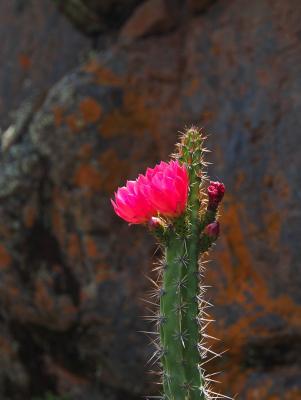
Cactus blooming
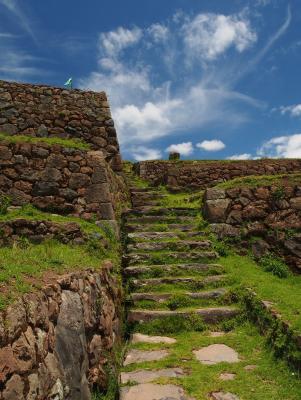
Steps between the many terraces
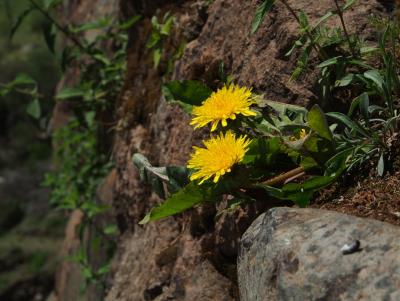
Nature reclaiming the walls
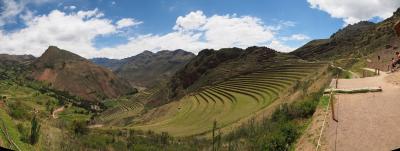
Again the terraces of Pisaq
Ollantaytambo:
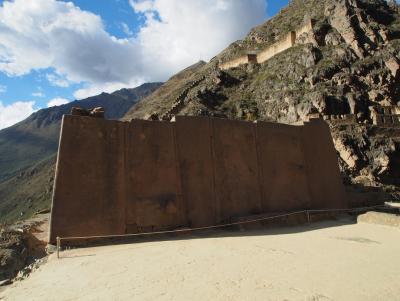
Monoliths of Ollantaytambo: They each weigh a couple of tons. Just imagine the knowhow and manual labor having gone into getting them first down one hill, across a river and then up another steep hill...
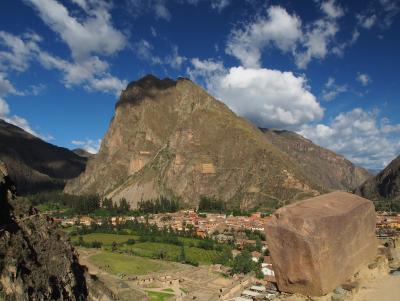
View from Ollantaytambo. On the other mountain you can see the storage houses. Also on the left side of the mountain one can make out (sorry, not with this small picture) a face silouette that is illuminated by the rising sun on a certain day of the year.
Chinchero:
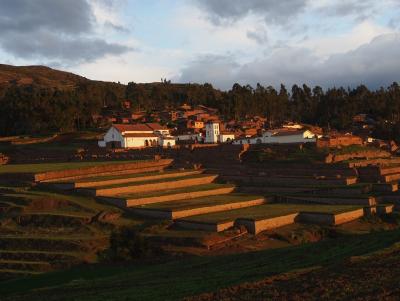
The ruins of Chinchero are undergoing major restauration at the moment so we could only observe them from afar. On top of them the Spanish built a very beautifull small church (late 16th or early 17th century, I believe). This was actually a highlight, especially because the decorations of the inside of the church is just fantastic and not as cheaply kitschy decor that I've encountered in most churches so far.
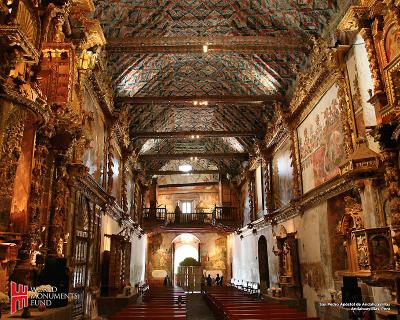
This is not a picture of mine (no photography allowed) but it shows you the beautifull interior with the intricate paintings all along the walls and ceiling.
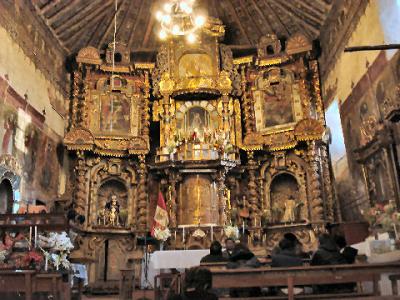
Chinchero Church Altar. Also not my picture.
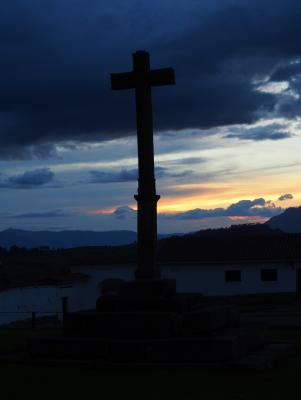
The cross outside the Chinchero Church in the waning sunset
This post describes actually two trips to the sacred valley that I did, one by public transport to Tipon together with two students from the language school and the other a tourist tour to the three ruins of Pisaq, Ollantaytambo and Chinchero. The Ruins of Moray and salt terraces of Maras (see earlier post) also are in the sacred valley.
Tipon:
This is a "water" temple containing many aquaeducts to honor Wiraqucha, the main god that created everything in the Incan mythology. He is representet by the main water body that is then split into two, the next two gods of the sun "Inti" and the moon "Killa" representing male and female. It then breaks down further and for example the 4 water fountains represent the 4 different elements fire, water, air and earth. If something is used with 3 then it usually represents the sky (represented by the Condor), the middle earth (maybe the mountains, represented by the Puma) and the lower earth (represented by the snake). It was also incredible to see the intricate aquaeduct system the Incas used to control the flow and velocity of the water. A very beautifull temple! We went rather late arriving only 1:15h before it closed and we had the place to ourselves with the gorgeous late afternoon light! Well worth the trip.

This is the main water display of the Incan cosmology.

The representation of the 4 elements fire, water, earth and air.

The Korean couple (they chose the "easier" names of Antonio and Tatiana for their travels in South Amercia) that I met at the language school. Two psychiatrists that I've really enjoyed spending time with!
Pisaq, Ollantaytambo and Chinchero:
This is the classic one day trip to the sacred Valley. It is somewhat of a "Kaffeefahrt" (for all non-Germans: this is a trip visiting some interesting place that is used to stop at "artistic" markets on the way to sell the tourists stuff on the way) and I think the tour company receives a provision for the market stops. Sadly that meant hardly enough time at the actual ruins with having to hurry through them and wasted time at markets. But at least the trip was cheap, 25 Soles (roughly 7 Euros) for the whole day (excluding food and entrance fees).
Pisaq:

Pisaq from the top of the ancient town looking down at the terraces

Cactus blooming

Steps between the many terraces

Nature reclaiming the walls

Again the terraces of Pisaq
Ollantaytambo:

Monoliths of Ollantaytambo: They each weigh a couple of tons. Just imagine the knowhow and manual labor having gone into getting them first down one hill, across a river and then up another steep hill...

View from Ollantaytambo. On the other mountain you can see the storage houses. Also on the left side of the mountain one can make out (sorry, not with this small picture) a face silouette that is illuminated by the rising sun on a certain day of the year.
Chinchero:

The ruins of Chinchero are undergoing major restauration at the moment so we could only observe them from afar. On top of them the Spanish built a very beautifull small church (late 16th or early 17th century, I believe). This was actually a highlight, especially because the decorations of the inside of the church is just fantastic and not as cheaply kitschy decor that I've encountered in most churches so far.

This is not a picture of mine (no photography allowed) but it shows you the beautifull interior with the intricate paintings all along the walls and ceiling.

Chinchero Church Altar. Also not my picture.

The cross outside the Chinchero Church in the waning sunset
... comment